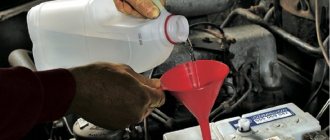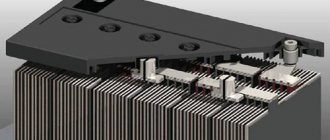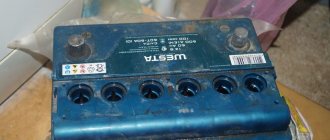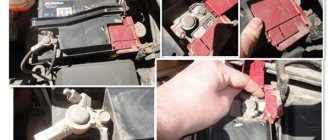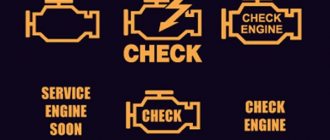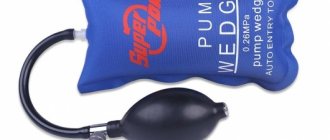Hello, dear friends! Every motorist has to regularly maintain and monitor the condition of his vehicle. And during operation, many different problems may appear. Today we are talking about cloudy electrolyte in the battery.
I propose to discuss the reasons for this phenomenon and what it means.
Some car enthusiasts are not even interested in why the electrolyte suddenly acquires such an uncharacteristic color and becomes cloudy. They are simply in a hurry to dispose of the battery faster and choose a new battery, installing it under the hood of the car.
But if you don’t find out about the reasons, there is a high probability that the same thing will happen to a new battery. And a battery for a car is not the cheapest pleasure.
What you need to know
Most car enthusiasts know that the electrolyte is a mixture prepared from sulfuric acid and distilled water.
In this case, the ratio of components is approximately 3 to 1, where there is 3 times more water than acid.
It is due to this environment that electrochemical processes take place inside the battery, allowing it to accumulate charge and then release it to start the engine and perform secondary tasks.
Normally, the electrolyte is a completely transparent liquid.
And if you think that clouding is normal, you are deeply mistaken.
Now you need to figure out what cloudy electrolyte means and what to do in a given situation.
Complete replacement of electrolyte in the battery
To replace the electrolyte in the battery, you must perform the following steps:
- Place the car on a level surface. If the design has a standard radio, then you need to find the unlocking code (needed to restore the player's functionality when the power is connected).
- Remove the cables and unscrew the fastenings of the power source, and then wipe the case from dust and traces of electrolyte with a cloth moistened with an aqueous solution of ammonia.
- Unscrew the caps of the cans or drill holes in the lid.
- To drain the liquid, you need to attach an extension tip to a medical syringe or rubber bulb, and then pump the solution out of the jars. It is forbidden to turn the battery case over, since sludge particles accumulated in the lower part of the casing will short the plates and damage the battery.
- To drain the maximum volume of electrolyte, you need to tilt the body at an angle of up to 45°, the solution is pumped out with a syringe or bulb. To remove electrolyte residues, it is necessary to fill the jars several times with distilled water; To speed up the procedure, rocking the body from side to side is allowed. It should be taken into account that it is impossible to completely wash out the electrolyte - the remaining solution remains in the cavities between the electrode grids.
- Fill the jars with the prepared reagent: the liquid level should be above the top edge of the electrodes.
- Keep the device indoors for 5-6 hours, and then charge the power source and check the performance of the battery. It is recommended to charge the product with a current of no more than 0.1 A, which is supplied for 18-20 hours. To restore capacity, it is necessary to perform 2-3 cycles of charging and discharging with low current.
- Carry out final charging with a current of 10% of the battery's rated capacity. Charging is carried out until the voltage is fixed at the terminals at 14.6-14.7 V. It is recommended to check the density of the electrolyte: if the value increases above the standard, distilled water is introduced into the solution.
- Install the battery on the car and connect the cables.
Not critical reasons
As you know, batteries are divided into 2 large categories. These are serviceable and maintenance-free batteries.
Their distinctive feature is the presence or absence of plugs on the battery cover, which allow access to the battery banks.
Accordingly, if the battery is serviceable, all 6 covers are unscrewed. Those that are not serviced have plugs or nothing at all. The state of the electrolyte can only be studied through the transparent part of the housing, if there is one, or by indirect characteristics. For example, based on the voltage in the battery or by testing with a load fork.
There are several ways to check batteries, but not all of them indicate that the electrolyte has become cloudy.
It would be logical to start with reasons that are not critical.
- Ingress of contaminants
. This is not the most common occurrence, but it cannot be ruled out. A motorist, working with a serviced battery, unscrewed the caps, accidentally dropped something in there, filled it in, filled it up, or simply did not wipe the case before opening it. As a result, the solution is no longer as light as before; - Bad water
. According to all canons and rules, only distillate is added to the battery. Some people pour process water, tap water, or liquid from household filters, considering it no worse than distillate. If anyone is interested, we will somehow devote a separate material to the issue of distilled water. Or we’ll just talk about battery maintenance; - Low electrolyte quality
. To save money, or out of despair, the first available electrolyte of unknown origin is poured into the battery during full maintenance. This can be done by the manufacturer himself, or by the motorist buying a dry-charged battery.
Alas, counterfeit electrolyte, like regular water instead of distilled water, is not uncommon on the domestic market. They often sell products under the guise of a well-known brand, which in fact are fake.
Therefore, you need to carefully select components for battery maintenance.
How to add electrolyte to a maintenance-free battery?
If the owner wants to add water or pour electrolyte into a maintenance-free battery, he will need to remove the lid of the cans or make holes in the upper part of the casing (the diagram depends on the design and manufacturer of the product). The channels are pierced with a sharp awl until they touch the lead electrodes. The technique allows you to determine the distance between the top edge of the cover and the lead plates. To ensure normal operation of the power source, the electrolyte level must be 10-15 mm above the top edge of the electrodes.
If the solution level is below the required value, then distilled water must be added. The liquid must be poured using a medical syringe or a rubber bulb with a capacity of 10-20 cm². The tool is equipped with a shortened needle; the length of the element allows you to control the level of liquid in the jars. The plastic base of the needle should not fall into the cavity of the jar through the hole.
The owner adds water by periodically reversing the piston or releasing the bulb body. If air is drawn into the cavity, filling continues.
After reaching the required level in all banks, it is recommended to shake the battery case, ensuring mixing of water and acid-containing solution. It is prohibited to shake the battery sharply or turn it on its side, as sludge will get between the electrodes. It is necessary to carry out a control measurement of the level: if there is little liquid in the jars, then it is necessary to introduce an additional portion of distilled water. The holes are sealed with sealant, then the power source is charged. Please note that adding water allows you to temporarily restore battery parameters.
Serious reasons
And this is a completely different category of reasons due to which cloudy electrolyte is formed in the battery.
- Recharge
. If you overexpose the battery while charging, the temperature will increase significantly. Heating causes the structure of the liquid to change. This occurs due to the effects of temperature and overcharge on the plates. They collapse, crumble, and these particles mix with the electrolyte. Therefore, you should not be surprised that after charging, carried out in violation of the recommendations, the liquid changed; - Discharge
. We are talking about a deep discharge, which is also detrimental to the plates. Therefore, this also affects the electrolyte itself. It is potentially possible to restore the battery. But not in the case when the plates have already fallen off; - Consequences of freezing
. The working fluid in the battery can freeze under certain conditions. Ice destroys the plates from the inside and damages the body. Hence the cloudy liquid.
As you already understand, all the reasons are somehow related to the shedding of the plates.
This can be caused by overcharging, deep discharge, frost, a simple fall, the use of low-quality liquids, etc.
Gray or black electrolyte is bad!
Let's say you defrosted the battery, but when you looked at the cans (battery compartments), it or two took on a black or thick gray color. I want to say right away, go get a new battery, what does this tell us, but nothing good:
When the water froze, it damaged the lead plates and simply destroyed them, or, if you like, tore them. After the electrolyte has defrosted and turned back into liquid, these compartments no longer have structured plates, but simply a bunch of lead that was mixed in the jar, which is why it became cloudy. Even if one bank fails, the voltage will drop by 2 Volts, that is, the nominal value will be 12 and 10 Volts. Such a battery will not be able to start your car, and what can it start, it is not even able to “soak” the car’s systems (radio, ECU, dashboard, etc.). This is the “death” of the battery.
Of course, many manage to restore this jar by cutting the top and pulling out - restoring the package of lead plates. But for an ordinary car enthusiast, this is very difficult and almost impossible. Let's go get a new battery.
The electrolyte is brown in the battery. In one or more banks. Why and what to do
Recently, one guy wrote to me on social networks about the brown electrolyte in the battery. Actually, the reason is trivial - before charging, the density in all banks was 1.15 g/cm3, one bank had a dark (brown) electrolyte. After charging, the battery was charged normally, the can became transparent. Why does this happen and what to do? To be honest, this does not happen with this jar, but it happens in all six. Let's find out...
THE CONTENT OF THE ARTICLE
To be honest, this phenomenon is not entirely good; of course, I already have an article about black and cloudy electrolyte. So this is a kind of continuation or addition, but there are small features here, I’m talking about the brown color now.
About plate packages
To explain it popularly, you first need to remember about plate packages. In a car battery, there are only six of them, according to the number of cans.
A package of plates is negative and positive plates collected in one package through special plastic “spacers” to prevent short circuits. As it becomes clear, the positive ones are connected to each other, and the negative ones are connected to each other. So these plates are made of the following, negative plates are lead, positive plates are made of lead dioxide.
After the “package” is assembled, it is placed in a plastic battery jar and filled with electrolyte (a mixture of distilled water - 65% and sulfuric acid - 35%). The plates interact with acid and water - they can accumulate or release a charge.
Destructive processes inside the battery
To be honest, the battery is a rather unstable unit. If you violate something in the charge-discharge cycles, or temperature readings. The battery can fail quite quickly. Here are a few items that can kill your battery.
SO:
- Recharges. May cause shedding of the active mass
- Lack of electrolyte. If the active mass of the package is exposed, this can also cause shedding
- Low temperatures. If your battery is discharged, it will simply freeze, thereby destroying both the case and the plates
- High temperatures. Too high temperatures in the summer, and under the hood it can be up to + 70 degrees, can also cause sulfation
These processes are known to everyone, but if we take, say, AGM or GEL batteries, they have completely different symptoms that can damage them. Therefore, you need to clearly understand what type you are taking and how to care for it. This should be done when choosing a battery, so that later it will not be excruciatingly painful for wasted money.
Why does brown plaque form?
Actually, now the answer to the main question is precisely why the brown precipitate appears.
When charging, the plates may change color, so to speak - a slightly brownish coating forms on the “plus” plates. But on the “minus” ones, a dark, I would even say black, coating forms. This is quite normal, but such a coating should not be intense, much less crumble.
Shedding of the active mass occurs mainly for one reason - long-term recharging of the battery with high current. The active substance begins to precipitate into the electrolyte, that is, in simple words, particles break off from the positive plates and fall into the electrochemical liquid. Because of this, a brown color is formed and the electrolyte becomes opaque. REMEMBER OVERCHARGING ALSO DOES NOT DO ANYTHING GOOD FOR YOUR BATTERY.
How much is high current? In general, manufacturers recommend charging with currents not exceeding 10% of the capacity. That is, if your battery has a capacity of 60 Ah, the charge should be a maximum of 6 Amps and no more! In general, it is better to use a lower current, say 2 - 3A, so the battery is charged evenly and does not heat up to a critical state.
However, if you provide 10, 12, 20 Amperes, you need to understand such currents simply kill your battery (now about the 60Ah option) - this is a BIG CURRENT. The plates simply heat up and the electrolyte begins to boil, because of this the overall temperature of the battery begins to creep up. And since lead and lead dioxide are soft metals (this is not the steel that is used in boilers), they begin to collapse (the active mass crumbles). Slowly but surely! And for some reason, it is the “plus” ones that suffer first, forming a brown tint to the electrolyte. It can suffer from one bank, usually the outermost one, the first or the sixth. All the others, that is, all six, can also suffer if they boil for a long time with high current.
To be fair, it is worth noting that similar consequences can occur due to an insufficient level of electrolyte in the banks, that is, if the plates are very exposed. And even if you supply 6A, they can warm up, so always monitor the level and add distilled water as needed.
What to do?
Often, on forums, you can see this - there was a brown electrolyte, density 1.15 (or, say, 1.17), charged to 1.27 g/cm3, everything became fine, the brown color went away.
Guys, he didn’t go anywhere, he simply settled to the bottom of the jar and is there in the form of sediment. The active mass from the plus plate has already crumbled and it will no longer be possible to restore it back. THIS IS REALLY BAD FOR YOUR BATTERY!
You just have to hope that the shedding is not so intense and that your battery will last at least for how long! After all, the mass may crumble a little, or the plus plate may completely collapse, leaving a brown sediment at the bottom of the jar.
What they suggest online is to rinse the jar/cans, replace the electrolyte with a new one and charge the battery! DO NOT DO THIS UNDER ANY CASE. Why? Yes, it’s very simple, when you start washing the jar, you will pick up the already fallen sediment from the bottom, these “scales” can get stuck between the plus and minus plates, thereby completely bridging the jar. IT JUST WILL NOT WORK.
Thus, just do not touch the battery, charge and drive until it logically dies. BUT remember that it is already nearby, and for example, for a winter launch, it may not be enough.
That's all for me, but now a short video about how to CORRECTLY charge your battery.
Sincerely yours, AUTOBLOGGER.
auto-blogger.ru
